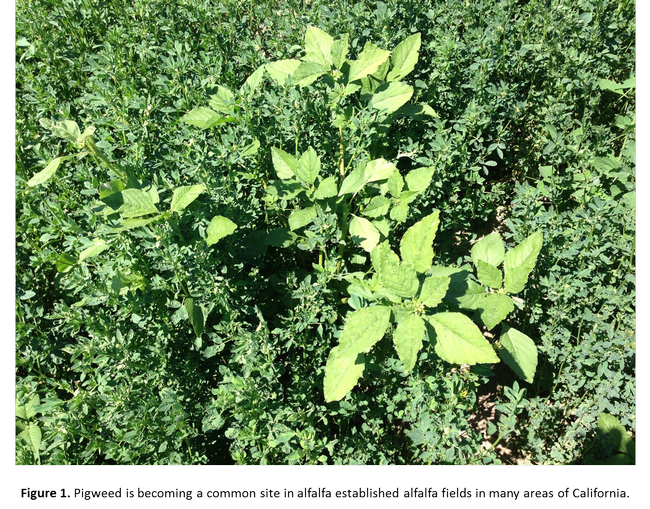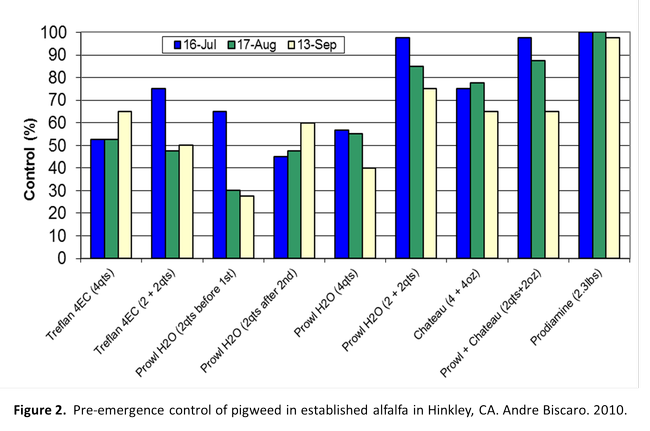- Author: Steve Orloff
Alfalfa is an excellent competitor with weeds. There is no better weed control method than a dense stand of alfalfa. However, even with a good stand, some weeds can get a foothold and infest the crop reducing its marketability. Most growers have an effective program to control winter annual weeds with a dormant season herbicide application. When it comes to summer annual weeds, grasses, such as green and yellow foxtail and barnyardgrass (also called watergrass), have historically been the most troublesome. While these weeds continue to be a major issue, there also appears to be an increase in pigweeds (both redroot and Palmer amaranth) in many areas of the state including the Central Valley, Intermountain Region and High Desert.
Exactly why pigweeds are becoming more prevalent in established alfalfa is not known. They are typically most serious in fields receiving applications of manure, but the problem is in no way restricted to these fields. Moisture level near the soil surface has a significant effect on the ability of pigweed to become established—higher moisture levels equate with higher infestation levels. With center pivot irrigation, some fields stay wetter between cuttings than they would with wheel-line sprinklers or flood irrigation, allowing pigweed to emerge and get a foothold between cuttings. However, pigweed is becoming more prevalent in alfalfa in the Central Valley, as well, where the overwhelming majority of fields are flood irrigated. Allowing fields to dry out more between cuttings can reduce summer annual weed infestations. However, alfalfa is believed to be most sensitive to water stress when the regrowth is coming on after a cutting. Therefore, while allowing soils to dry out more between cuttings may be effective for pigweed management, it could cut into yield—a high price to pay for weed control.
There is no simple herbicide solution to controlling pigweed in established alfalfa. The winter dormant soil-residual herbicides applied in December to March (timing depends on the geographic area of the state) usually do no persist long enough to adequately control pigweed. A trial was conducted in the High Desert by UC Farm Advisor Andre Biscaro to evaluate pre- and post-emergence control of pigweed in established alfalfa. The most effective pre-emergence treatments were a split application of Prowl H2O, a tank mix of Prowl and Chateau, and the longest lasting treatment was the herbicide prodiamine (not registered for alfalfa), which provided near perfect control for the entire season (Figure 2).
Several post-emergence herbicides were also evaluated but none were highly effective. Pursuit initially provided 80 percent control but as the season progressed, control fell to less than 40 percent. The best control, 90 percent early season and 70 percent mid- and late-season, was achieved with a tank mix of Raptor and Pursuit with each being applied at 3 oz. per acre.
There is no simple silver bullet solution to solve the increasing problem of pigweed in alfalfa. The problem is seen in both conventional and RR alfalfa fields. Pigweed, including Palmer amaranth resistance to glyphosate has yet to be documented in California. Application timing is important in RR alfalfa fields. For glyphosate to be effective, the application must be made after the pigweed has emerged, but before it becomes too large. A pre-emergence application of a dinitroaniline herbicide such as Prowl is partially effective (see Figure 2) in both RR and conventional fields but may require two applications depending on the area. The importance of controlling pigweeds on field borders and irrigation canals cannot be overstated. Pigweed often gets started there first and subsequently invades alfalfa fields.




